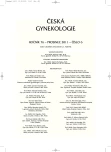-
Medical journals
- Career
Quiscent trophoblastic disease
Authors: F. Hron; V. Hejda; J. Feyereisl; P. Šafář; H. Sochová
Authors‘ workplace: Ústav pro péči o matku a dítě, Praha, ředitel doc. MUDr. J. Feyereisl, CSc. ; Centrum pro trofoblastickou nemoc v ČR, Praha
Published in: Ceska Gynekol 2011; 76(6): 443-446
Category: Original Article
Overview
Type of study:
Case report.Setting:
Center for trophoblastic disease in Czech Republic, Institute for care of mother and child, 3rd Faculty of Medicine of Charles University Prague.Methods:
The autors present a case of quiscent trophoblastic disease diagnosed at 27 years old primipara, secundigravida after previous molar pregnancy. The patient had low levels of serum hCG present for more than 18 months after the termination of pregnancy. After this period there was a malignant transformation associated with rapid elevation of hCG levels with need for chemotherapy which was succesfully completed.Conclusion:
Quiscent (dormant, noninvasive) trophoblastic disease is a recently described unit defined by low levels of hCG present in patients serum and urine samples without any evidence of trophoblastic tumour or other source of hCG production. Quiscent trophoblastic disease is associated with high risk of malignant transformation.Key words:
quiscent, trophoblastic, noninvasive, persistent, hCG.
Sources
1. Cole, LA., Khanlian, SA. Inappropriate management of women with persistent low hCG results. J Reprod Med, 2004, 49, p. 423‑432.
2. Cole, LA., Shahabi, S., Oz, UA., et al. Hyperglycosylated hCG (invasive trophoblastic antigen) immunoassay: a new basis for gestational Down syndrome screening. Clin Chem, 1999, 45, p. 2109-2119.
3. Cole, LA., Kohorn, E., Harriet, O., Smith, MD. Gestational Trophoblastic Disease: Management of cases with persistent low human chorionic gonadotropin results. Obstet Gynecol Clin N Am, 2005, 32, p. 615-626.
4. Cole, LA., Miller, CY. Hyperglycosylated hCG in the management of quiscent and chemorefractory gestational trophoblastic disease. Gynecol Oncol, 2010, 116(1), p. 3-9.
5. Hancock, BW., Tidy, JA. Clinical management of persistent low level hCG elevation. Trophobl Dis Upd, 2004, 4, p. 5-6.
6. Khanlian, SA., Smith, HO., Cole, LA. Persistent low levels of hCG: a premalignant gestational trophoblastic disease. Am J Obstet Gynecol, 2003, 188, p. 1254-1259.
7. Kohorn, EI. Persistent low-level „real“ human chorionic gonadotropin: a clinical challenge and a therapeutic dilema. Gynecol Oncol, 2002, 85, p. 315-320.
8. Kovaleskaya, G., Genbacev, O., Fisher, SJ., et al. Trophoblast origin of hCG isoforms, cytotrophoblasts are the primary source of choriocarcinoma-like hCG. Mol Cell Endocrinol, 2002, 194, p. 147-155.
9. Zavadil, M. Trophoblastic disease. Praha: Acta Univ Carol Med, 1973, 19, 107 s.
10. Zavadil, M., Feyereisl, J., Krofta, L., et al. Persistent trophoblastic disease in Trophoblastic Disease Center in the Czech Republic in 1955-2007. Ces Gynek, 2008, 73(2), p. 73-79.
Labels
Paediatric gynaecology Gynaecology and obstetrics Reproduction medicine
Article was published inCzech Gynaecology

2011 Issue 6-
All articles in this issue
- Laparoscopic approach in the pelvic floor surgery
- Diagnosis and management in women with lower urinary tract symptoms (LUTS) after Burch colposuspension
- Prenatal diagnosis and management of fetuses with congenital diaphragmatic hernia
- Quiscent trophoblastic disease
- Ultrasound imaging of normal fetal central nervous system at 8 to 12 weeks of gestation
- Possibilities of 4D ultrasonography in imaging of the pelvic floor structures
- Use of ultrasound in labor
- Characteristics and prognosis of malignant disease of the breast in women of very low age
- Robot assisted laparoscopic staging of endometrial cancer – comparison with standard laparotomy
- Genital warts and HPV vaccination
- Compare of misoprostol and dinoprost effectivity by induced second-trimester abortion
- Transurethral injection of polyacrylamide hydrogel (Bulkamid) for the treatment of female stress urinary inkontinence and changes in the cure rate over time
- Quality and effectiveness of electronic fetal monitoring
- Czech Gynaecology
- Journal archive
- Current issue
- Online only
- About the journal
Most read in this issue- Use of ultrasound in labor
- Compare of misoprostol and dinoprost effectivity by induced second-trimester abortion
- Prenatal diagnosis and management of fetuses with congenital diaphragmatic hernia
- Quiscent trophoblastic disease
Login#ADS_BOTTOM_SCRIPTS#Forgotten passwordEnter the email address that you registered with. We will send you instructions on how to set a new password.
- Career

